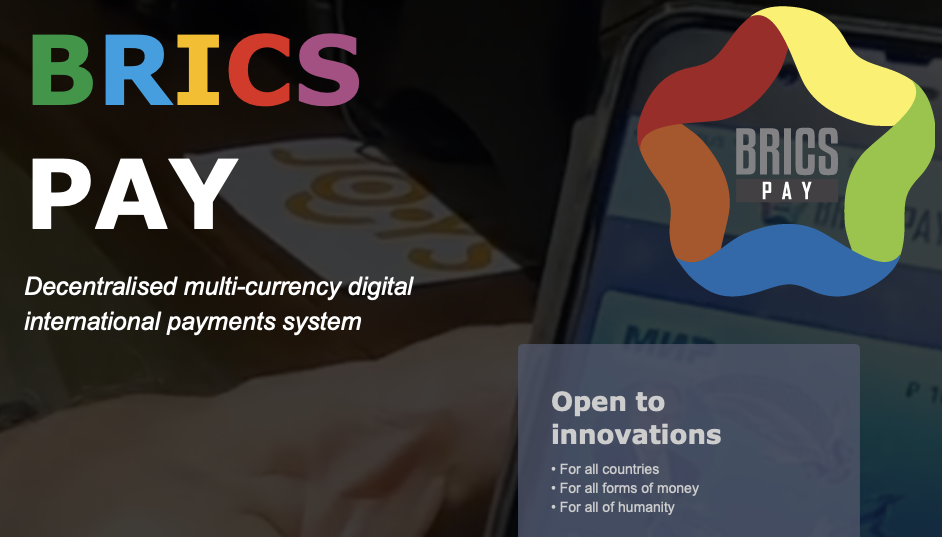Table of Contents
ToggleIntroduction
BRICS PAY is a new payment system being developed by Brazil, Russia, India, China, and South Africa. It aims to create a decentralized multi-currency digital payment platform for international transactions. This system could change how money moves between countries.
The BRICS nations are working on a payment system that uses blockchain and digital currencies. This move shows their desire to reduce reliance on Western financial networks. The system will allow users to make payments in their local currencies, making cross-border transactions easier and cheaper.
BRICS PAY might launch as early as October 2024. Over 150 countries have shown interest in using it. This wide interest suggests that BRICS PAY could become a major player in global finance. It may offer an alternative to current systems like SWIFT.
Key Takeaways
- BRICS PAY is a new digital payment system developed by Brazil, Russia, India, China, and South Africa
- The system uses blockchain technology and allows payments in local currencies
- BRICS PAY could launch in October 2024 with potential adoption by over 150 countries
Overview of BRICS PAY
BRICS PAY is a new payment system for Brazil, Russia, India, China, and South Africa. It aims to make cross-border payments easier and cheaper between these countries.
Concept and Design
BRICS PAY is a decentralized payment system that lets people send money across borders. It works like Europe’s SWIFT system but for BRICS nations. The system uses blockchain technology to keep transactions safe and fast.
BRICS PAY lets users pay in their own local money. This means less need to change currencies. It could make trade between BRICS countries simpler and cheaper.
The system was launched in 2018 by the BRICS Business Council. Experts from all five countries helped create it. They focused on making a system that works well for banks, businesses, and people.
Member Countries
The BRICS PAY system includes five major economies:
- Brazil
- Russia
- India
- China
- South Africa
These countries make up about 40% of the world’s population. They also have a big share of global trade. BRICS PAY helps them work together more closely on money matters.
Each country brings something unique to the system. For example, India has experience with its own Unified Payments Interface. China has advanced mobile payment tech. These strengths help make BRICS PAY better.
The system could grow to include more countries in the future. This might help it compete with other global payment systems.
Technical Infrastructure
BRICS Pay relies on advanced technology to enable cross-border payments. Its architecture focuses on security and efficient processing.
Payment Processing Architecture
BRICS Pay uses a decentralized system to handle transactions between member countries. This allows for direct transfers without relying on intermediary banks.
The system likely incorporates blockchain technology to record and verify transactions. This provides transparency and reduces the risk of errors.
BRICS Pay aims to support multiple currencies from BRICS nations. It may use a shared digital currency or token to facilitate conversions between different national currencies.
The architecture likely includes interfaces with existing national payment systems in each BRICS country. This allows for seamless integration with local banking networks.
Security and Encryption
Strong encryption protects all data transmitted through the BRICS Pay network. This keeps financial information and transaction details safe from unauthorized access.
The system employs multi-factor authentication for users and institutions. This may include biometrics, hardware tokens, or other advanced verification methods.
BRICS Pay likely uses distributed ledger technology to prevent fraud and tampering. Each transaction is recorded across multiple nodes, making it extremely difficult to alter records.
Regular security audits and penetration testing help identify and address potential vulnerabilities. This ongoing process ensures the system remains robust against emerging threats.
Economic Implications
BRICS Pay could reshape international trade and currency dynamics. It may reduce reliance on traditional payment systems and boost economic cooperation among BRICS nations.
Trade Facilitation
BRICS Pay aims to streamline cross-border transactions between Brazil, Russia, India, China, and South Africa. This system could lower transaction costs and speed up payments, making trade easier.
Businesses may save money on currency conversion fees. Faster payments could improve cash flow for companies involved in international trade.
The system might also open up new markets. Smaller businesses could find it easier to engage in cross-border commerce.
BRICS Pay could reduce the risk of payment disruptions due to geopolitical tensions. This stability might encourage more trade between BRICS nations.
Currency Stabilization Effects
BRICS Pay could help stabilize the currencies of member countries. By enabling direct exchanges, it may reduce the need for U.S. dollars in trade.
This could lead to less volatile exchange rates for BRICS currencies. More stable currencies might attract foreign investment to these countries.
The system could also increase the use of local currencies in international trade. This might strengthen the global position of currencies like the Chinese yuan.
Over time, BRICS Pay might contribute to a more diverse global financial system. It could offer an alternative to dollar-dominated trade, potentially shifting global economic power dynamics.
Deployment Strategy
BRICS Pay will roll out in stages across member countries. Testing in select areas will precede wider adoption.
Phased Implementation
The BRICS Pay system will launch gradually. Phase 1 targets internal use among BRICS nations. This allows for system refinement before expanding. Key steps include:
- Infrastructure setup in each country
- Integration with local banking systems
- Staff training on the new platform
- Regulatory compliance checks
Phase 2 broadens access to other interested nations. This wider rollout builds on lessons from the initial phase.
Phase 3 aims for global reach. It focuses on attracting businesses and consumers worldwide to use BRICS Pay.
Pilot Programs
Pilot tests will happen in major cities across BRICS nations. These programs help identify and fix issues early.
Pilot locations may include:
- Mumbai, India
- Shanghai, China
- Moscow, Russia
- São Paulo, Brazil
- Johannesburg, South Africa
Each pilot will involve a mix of banks, businesses, and consumers. Feedback from these tests will shape the final system.
Pilots also serve to build public trust. They demonstrate the system’s reliability and ease of use. This can boost adoption when BRICS Pay launches fully.
Legal and Regulatory Framework
BRICS Pay faces complex legal and regulatory challenges across multiple countries. Each member nation has its own rules for financial transactions and data protection.
International Compliance
BRICS Pay must follow international payment standards to operate globally. This includes anti-money laundering (AML) and know-your-customer (KYC) rules.
The system needs to verify user identities and track transactions to prevent illegal activities. Each BRICS country has different AML and KYC requirements.
Data privacy laws also vary between nations. BRICS Pay must protect user information while sharing necessary data with authorities.
Cross-Border Regulations
Moving money between countries brings extra rules. BRICS Pay has to follow currency exchange regulations in each member state.
Some BRICS nations have limits on how much money can leave the country. The payment system must track these limits and stop transfers that break rules.
Tax laws for international payments differ in each country. BRICS Pay may need to report certain transactions to tax authorities.
The system also faces challenges with different national payment systems. It must connect smoothly with platforms like India’s UPI and Russia’s Mir.
Integration with Existing Financial Systems
The BRICS Pay system aims to seamlessly connect with current financial infrastructure. This involves adapting banking systems and ensuring compatibility with other payment networks.
Banking Sector Adaptation
Banks in BRICS countries are updating their systems to work with BRICS Pay. They are adding new software and training staff on the platform.
Some banks have already started testing BRICS Pay. Standard Chartered Bank integrated it into their digital payment platform. This allows their customers to send money to other BRICS nations easily.
Banks are also working on security measures. They need to protect customer data and prevent fraud on the new system.
Compatibility with Other Payment Systems
BRICS Pay must work with existing payment systems in each country. In India, it needs to connect with the Unified Payments Interface (UPI). For Russia, integration with the Mir system is key.
The system uses blockchain technology to help with this integration. Blockchain allows for secure, transparent transactions across different platforms.
Developers are creating APIs to link BRICS Pay with local payment apps. This will let people use familiar apps while still accessing the BRICS network.
Consumer and Merchant Adoption
The success of BRICS Pay hinges on wide acceptance by both consumers and merchants. Key factors driving adoption include financial incentives and a smooth user experience.
Incentive Structures
BRICS Pay aims to boost adoption through targeted incentives. For consumers, these may include cashback rewards on transactions and lower fees compared to traditional payment methods. Merchants benefit from reduced transaction costs and faster settlement times.
Some countries are considering tax breaks for businesses that integrate BRICS Pay. This could lead to significant savings, especially for companies engaged in cross-border trade within BRICS nations.
Early adopters may receive extra perks. These could include higher initial cashback rates or waived fees for a set period. Such offers can create buzz and encourage people to try the new system.
User Experience Enhancements
BRICS Pay focuses on creating a seamless payment process. The system aims to work across multiple devices, including smartphones, tablets, and computers. This flexibility allows users to pay how they prefer.
One key feature is a unified QR code system. This lets merchants display a single code that works for all BRICS Pay users, regardless of their home country. For consumers, this means no need to juggle multiple apps or payment methods when traveling within BRICS nations.
The platform also plans to offer real-time currency conversion. This feature will display prices in the user’s home currency, making it easier to understand costs when shopping abroad. Clear, upfront information about exchange rates and fees helps build trust with users.
Comparison with Other Payment Systems
BRICS PAY aims to reshape international payments by offering unique features and advantages. It faces competition from established systems but brings its own strengths to the table.
Differentiators of BRICS PAY
BRICS PAY stands out by reducing reliance on the US dollar for cross-border transactions. This system allows member countries to use their own currencies for international trade.
It operates as a decentralized and independent payment messaging mechanism. This structure gives BRICS nations more control over their financial transactions.
BRICS PAY is designed to work alongside existing systems rather than fully replace them. It aims to provide an alternative for countries facing economic sanctions or seeking financial independence.
Competitive Analysis
BRICS PAY’s main competitor is SWIFT (Society for Worldwide Interbank Financial Telecommunication). SWIFT has been the dominant global payment system for decades.
Key differences:
- Coverage: SWIFT operates globally, while BRICS PAY focuses on BRICS nations and their partners.
- Currency options: SWIFT primarily uses USD, while BRICS PAY enables local currency transactions.
- Governance: SWIFT is Western-dominated, whereas BRICS PAY is controlled by BRICS countries.
BRICS PAY also competes with regional systems like China’s CIPS and Russia’s SPFS. These alternatives aim to reduce dependence on Western-controlled financial networks.
Challenges and Risks
The BRICS Pay system faces several hurdles as it aims to transform international payments. These include operational issues and complex geopolitical factors that could impact its adoption and effectiveness.
Operational Risks
BRICS Pay must overcome significant technical and regulatory obstacles. The system needs to integrate different national payment systems, each with its own rules and technologies. This integration is complex and time-consuming.
Cybersecurity is another major concern. The system must protect against hacks and fraud attempts. This is crucial for building trust among users and partner countries.
Standardization across BRICS nations poses challenges too. Each country has unique financial regulations. Aligning these rules while maintaining compliance is a difficult task.
Geopolitical Considerations
The creation of BRICS Pay has significant political implications. It’s seen as a move to reduce reliance on Western financial systems. This could lead to tensions with countries outside the BRICS group.
The system’s success depends on widespread adoption. But some nations may hesitate due to political pressures or existing financial ties.
Sanctions and trade restrictions could also affect BRICS Pay. Countries might face challenges in using the system if it conflicts with international sanctions.
Balancing the interests of all BRICS members is crucial. Disagreements over control and governance of the system could hinder its progress.
Future Developments
BRICS Pay is set to evolve with new technologies and expand its reach. The system aims to enhance cross-border transactions and reduce reliance on Western financial networks.
Technological Advancements
BRICS Pay plans to integrate central bank digital currencies (CBDCs) into its platform. This move will enable faster and more secure international transfers. The system will also incorporate blockchain technology to improve transparency and reduce fraud.
Artificial intelligence will play a key role in detecting suspicious activities and ensuring compliance with financial regulations. BRICS Pay developers are working on advanced encryption methods to protect user data and transaction details.
The platform will support tokenized assets, allowing for easier trading of various financial instruments across borders. This feature could open up new investment opportunities for BRICS nations.
Expansion Plans
BRICS Pay aims to extend its services beyond the founding nations. The system will invite other emerging economies to join, potentially creating a global network of alternative payment options.
The platform plans to develop partnerships with major financial institutions and tech companies. These collaborations will help BRICS Pay integrate with existing payment systems and expand its user base.
BRICS Pay intends to offer its services to businesses of all sizes, from small merchants to large corporations. This broad approach aims to create a comprehensive ecosystem for international trade and finance.
Frequently Asked Questions
BRICS PAY aims to simplify cross-border payments for its member countries. This system offers benefits for international transactions and works with existing financial structures. Let’s explore some common questions about BRICS PAY.
How does the BRICS PAY payment system operate within its member countries?
BRICS PAY allows users to make payments in their local currencies across BRICS nations. It connects the payment systems of Brazil, Russia, India, China, and South Africa. This creates a unified platform for seamless transactions between these countries.
What are the benefits of using the BRICS PAY payment system for international transactions?
BRICS PAY offers lower transaction costs for cross-border payments. It also speeds up transfer times between member countries. The system enables financial integration among BRICS nations, making trade and business easier.
When was the BRICS PAY payment system officially launched?
The BRICS PAY project began in 2018 under the BRICS Business Council. However, its full launch and implementation have been gradual. The first BRICS PAY transaction took place in a Moscow store recently.
Can BRICS PAY be integrated with existing cryptocurrency platforms?
Information about BRICS PAY’s integration with cryptocurrency platforms is limited. The system focuses on traditional currencies of BRICS nations. Its main goal is to facilitate fiat currency transactions between member countries.
Which mobile platforms support the BRICS PAY application, and where can it be downloaded?
Details about BRICS PAY mobile applications are not widely available. The system is still in development, and information about supported platforms or download locations is not clear.
What impact does the BRICS PAY payment system have on traditional banking systems within BRICS nations?
BRICS PAY aims to work alongside existing banking systems. It provides an alternative for international transactions within BRICS countries. This system may reduce reliance on Western-dominated payment networks like SWIFT for transactions between BRICS nations.












